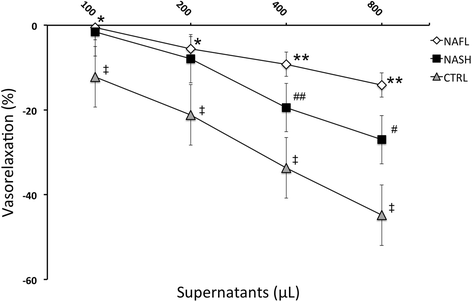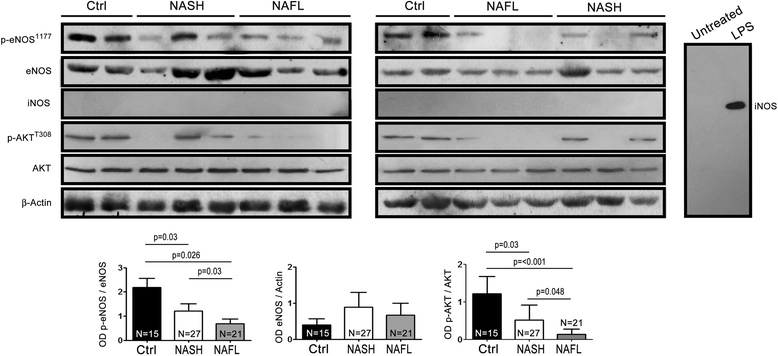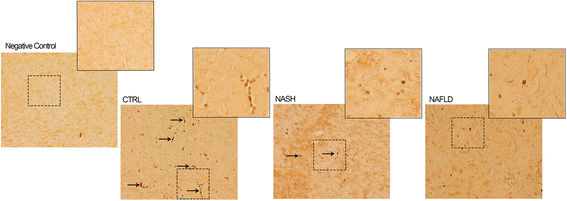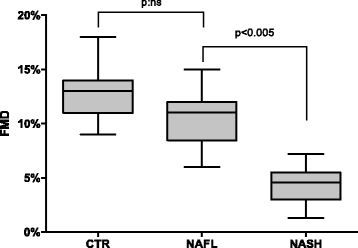"Non alcoholic fatty liver disease and eNOS dysfunction in humans"
- PMID: 28264657
- PMCID: PMC5340006
- DOI: 10.1186/s12876-017-0592-y
"Non alcoholic fatty liver disease and eNOS dysfunction in humans"
Erratum in
-
Correction to: "Non alcoholic fatty liver disease and eNOS dysfunction in humans".BMC Gastroenterol. 2017 Nov 8;17(1):116. doi: 10.1186/s12876-017-0671-0. BMC Gastroenterol. 2017. PMID: 29117861 Free PMC article.
Abstract
Background: NAFLD is associated to Insulin Resistance (IR). IR is responsible for Endothelial Dysfunction (ED) through the impairment of eNOS function. Although eNOS derangement has been demonstrated in experimental models, no studies have directly shown that eNOS dysfunction is associated with NAFLD in humans. The aim of this study is to investigate eNOS function in NAFLD patients.
Methods: Fifty-four NAFLD patients were consecutively enrolled. All patients underwent clinical and laboratory evaluation and liver biopsy. Patients were divided into two groups by the presence of NAFL or NASH. We measured vascular reactivity induced by patients' platelets on isolated mice aorta rings. Immunoblot assays for platelet-derived phosphorylated-eNOS (p-eNOS) and immunohistochemistry for hepatic p-eNOS have been performed to evaluate eNOS function in platelets and liver specimens. Flow-mediated-dilation (FMD) was also performed. Data were compared with healthy controls.
Results: Twenty-one (38, 8%) patients had NAFL and 33 (61, 7%) NASH. No differences were found between groups and controls except for HOMA and insulin (p < 0.0001). Vascular reactivity demonstrated a reduced function induced from NAFLD platelets as compared with controls (p < 0.001), associated with an impaired p-eNOS in both platelets and liver (p < 0.001). NAFL showed a higher impairment of eNOS phosphorylation in comparison to NASH (p < 0.01). In contrast with what observed in vitro, the vascular response by FMD was worse in NASH as compared with NAFL.
Conclusions: Our data showed, for the first time in humans, that NAFLD patients show a marked eNOS dysfunction, which may contribute to a higher CV risk. eNOS dysfunction observed in platelets and liver tissue didn't match with FMD.
Keywords: Endothelial dysfunction; Insulin resistance; Metabolic syndrome; Non-alcoholic fatty liver disease.
Figures




Similar articles
-
Deficiency of eNOS exacerbates early-stage NAFLD pathogenesis by changing the fat distribution.BMC Gastroenterol. 2015 Dec 17;15:177. doi: 10.1186/s12876-015-0409-9. BMC Gastroenterol. 2015. PMID: 26678309 Free PMC article.
-
Insulin resistance and liver microcirculation in a rat model of early NAFLD.J Hepatol. 2011 Nov;55(5):1095-102. doi: 10.1016/j.jhep.2011.01.053. Epub 2011 Feb 26. J Hepatol. 2011. PMID: 21356259
-
Evidence of NAFLD progression from steatosis to fibrosing-steatohepatitis using paired biopsies: implications for prognosis and clinical management.J Hepatol. 2015 May;62(5):1148-55. doi: 10.1016/j.jhep.2014.11.034. Epub 2014 Dec 1. J Hepatol. 2015. PMID: 25477264
-
Intrahepatic vascular changes in non-alcoholic fatty liver disease: Potential role of insulin-resistance and endothelial dysfunction.World J Gastroenterol. 2017 Oct 7;23(37):6777-6787. doi: 10.3748/wjg.v23.i37.6777. World J Gastroenterol. 2017. PMID: 29085222 Free PMC article. Review.
-
Pediatric non-alcoholic fatty liver disease: Recent solutions, unresolved issues, and future research directions.World J Gastroenterol. 2016 Sep 28;22(36):8078-93. doi: 10.3748/wjg.v22.i36.8078. World J Gastroenterol. 2016. PMID: 27688650 Free PMC article. Review.
Cited by
-
Integrative omics analysis identifies macrophage migration inhibitory factor signaling pathways underlying human hepatic fibrogenesis and fibrosis.J BioX Res. 2019 Mar;2(1):16-24. doi: 10.1097/jbr.0000000000000026. J BioX Res. 2019. PMID: 32953199 Free PMC article.
-
Non-parenchymal hepatic cell lipotoxicity and the coordinated progression of non-alcoholic fatty liver disease and atherosclerosis.Curr Opin Lipidol. 2018 Oct;29(5):417-422. doi: 10.1097/MOL.0000000000000535. Curr Opin Lipidol. 2018. PMID: 30015675 Free PMC article. Review.
-
Reactive Oxygen Species in the Aorta and Perivascular Adipose Tissue Precedes Endothelial Dysfunction in the Aorta of Mice with a High-Fat High-Sucrose Diet and Additional Factors.Int J Mol Sci. 2023 Mar 30;24(7):6486. doi: 10.3390/ijms24076486. Int J Mol Sci. 2023. PMID: 37047458 Free PMC article.
-
Potential utility of the fatty liver index as a predictor of erectile dysfunction and its severity.BMC Urol. 2025 Jul 25;25(1):183. doi: 10.1186/s12894-025-01865-w. BMC Urol. 2025. PMID: 40713641 Free PMC article.
-
A Novel Vasoactive Peptide "PG1" from Buffalo Ice-Cream Protects from Angiotensin-Evoked High Blood Pressure.Antioxidants (Basel). 2021 Mar 12;10(3):441. doi: 10.3390/antiox10030441. Antioxidants (Basel). 2021. PMID: 33809389 Free PMC article.
References
-
- Chalasani N, Younossi Z, Lavine JE, Diehl AM, Brunt EM, Cusi K, Charlton M, Sanyal AJ. The diagnosis and management of non-alcoholic fatty liver disease: practice Guideline by the American Association for the Study of Liver Diseases, American College of Gastroenterology, and the American Gastroenterological Association. Hepatology. 2012;55(6):2005–2023. doi: 10.1002/hep.25762. - DOI - PubMed
MeSH terms
Substances
LinkOut - more resources
Full Text Sources
Other Literature Sources
Medical

